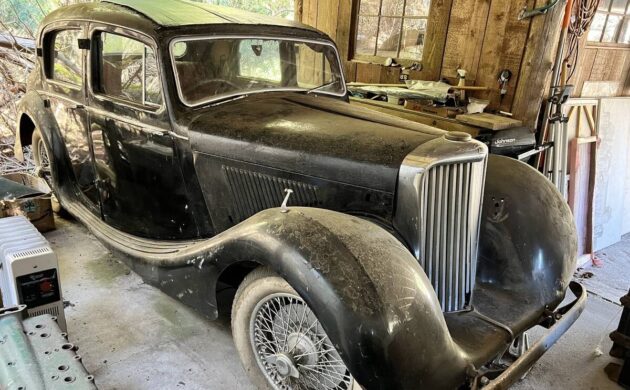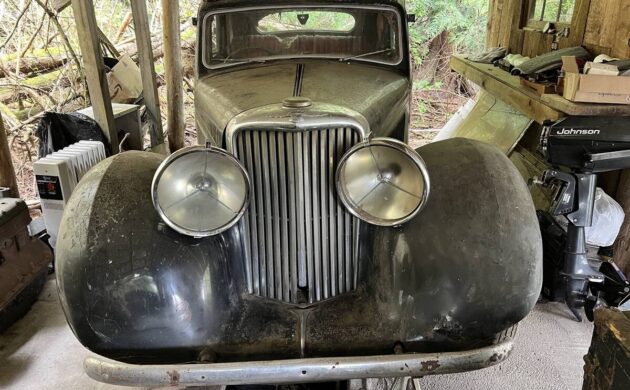Before WWII, Jaguar was evolving out of William Lyons’ Swallow Sidecar Company. Lyons managed to keep his company afloat during the Depression by joining with Standard to make a sports car. The SS1 was introduced in 1931 and produced in 1932 in touring, saloon, coupe, and drophead body styles. As the SS designs developed with ever-increasing horsepower, Lyons began using the name “Jaguar” appended to SS to describe his cars, connoting elegance, swiftness and forward movement. By 1935, the SS Jaguar line included a 1 1/2 liter car on a 112.5 inch wheelbase; and 2 1/2 and 3 1/2 liter cars on longer wheelbases. Collectively, these were known as the “Liter” cars. After WWII, the company changed its name to Jaguar Cars Ltd, and it picked up production of these same cars that it had to abandon in 1940. These became known retrospectively as the Mark IV once the Mark V was introduced. Here on craigslist is a 1948 Jaguar Mark IV 1 1/2 liter saloon, with an asking price of $12,950. This project car is located on Lopez Island, Washington.
Of the three “Liter” cars, only this one has an unmodified Standard-supplied in-line four-cylinder 1772 cc engine making about 70 hp. The 2 1/2 and 3 1/2 liter cars used Standard in-line six-cylinder engines modified by Harry Weslake to use overhead valves, resulting in a significant power boost. This car should have a Standard-supplied four-speed manual gearbox. Research shows that the larger cars received Moss gearboxes. The seller says this engine turns over and the mechanical Girling brakes do work. The dashpot for the SU carburetor, the air cleaner, and likely the valve cover (replaced by tin foil) are missing. While these smaller Mark IVs were less powerful than their siblings, top speed was still around 75 mph and fuel economy was great for the time, at about 25 mpg.
A number of Mark IVs were produced in left hand drive, since post-war Britain was encouraging its industrial companies to export as much as possible. This example, however, is not one of them. Still, Jaguar’s consistently luxurious appointments are evident, though shabby: leather seating, a wood dash, and gauges including a tachometer with a clock inset, water temp/oil pressure, ammeter, petrol, and speedometer were more commonly found on much more expensive cars. While the left-hand label on the heater/demister controls says “air conditioning”, it really meant “conditioning the air” i.e., producing heat when the cabin occupants were chilly in the British winter. A tool tray should be beneath the panel inside the trunk lid.
The Lucas P100 headlamps come with the car but are not permanently installed. While the body is described as “not rusty”, there’s plenty to do here and it’s time to consider this one’s price. Unfortunately, these smaller “Liter” cars sell for less than the larger displacement cars, and saloons sell for less than the touring or drophead styles. Here is a running, driving, slightly needy 3 1/2 liter saloon that sold two years ago for $32k – and this is the “big block” with left hand drive. On the other hand if a collector yearns for a Mark IV with a larger-engine and a drop-top, the price will easily exceed $100k. Do you think there’s a buyer for this one?






Quite car here. Michelle, you must have had to dig deep to come up with all the minute details of this car. One of these in relatively good condition is pretty rare. There’s got to be a British car collector here in the states who would love to get his hands on this one.
She’s a beauty, but with all that tinfoil on its engine and crooked Uninstalled eyeballs, it looks like a scary proposition to me. Although I can appreciate her heritage.
I would have never thought “Jaguar” looking at this car, lol.
A lot of work ahead for the person who picks this one up, and I like old cars, but this one doesn’t have much appeal.
What are they cooking on this Cat’s engine? Rib roast? I’ve seen this done before.
Check out Manifold Destiny, the cookbook for engine chefs.
https://www.amazon.com/Manifold-Destiny-Guide-Cooking-Engine/dp/1416596232/ref=asc_df_1416596232/?tag=hyprod-20&linkCode=df0&hvadid=312111884081&hvpos=&hvnetw=g&hvrand=16995085157260630835&hvpone=&hvptwo=&hvqmt=&hvdev=c&hvdvcmdl=&hvlocint=&hvlocphy=9033061&hvtargid=pla-448676447507&psc=1
Growing up in Scotland I was very fortunate and that my father bought a 1947 Jaguar 1 1/2 litre and used it as a daily driver for quite a while. Although my brother and I were young, we appreciated that this car was something special and begged dad not to sell it when the time came.
I can still remember the knock off wheels, the spacious back seat, the license number (HXU516), etc., but had forgotten other details such as front suicide doors.
Good memories, but this car is too far from here too even go look at.
More’s the pity.
Its going to cost you about $100 bucks+/- to get it off the island you could save some money on the ferry fee if you have a rollback instead of a trailer. Make a weekend of it that is a beautiful area to visit.
Hi Michelle, great write-up that reminded me of my Sunday “wash and wipe” a Jaguar Mk 4 job back in 1954. Very big car for a small schoolboy, however, it was a lovely car and yes, maybe it could do 75 mph but it would take a long time to get there!
Another candidate for an LS swap. Go ahead and shoot me for saying it. Unless you’re the right person to do it right, might as well
RDRNR – LS wont fit. Remember, this is a small-ish car with a 1.5 liter (1500cc) engine. That engine bay is small. If you want modern, you might could swing a 2 liter VORTEC or similar and not have a fit issue (but then you’d have to upgrade the brakes to stop it going from 30+HP to 200).
Personally, I’d go one of two ways if I wasn’t going back stock. Ok 3… 1800 from a 60’s MG, 1500 from a Spitfire, or try the 2.5 from a TR6. Tight, but might fit. The latter two are “Standard” engines for engine manufacturer hence that part would be the same.
How bout a Toyota 22R with a manual trans? It’s about right size without being overkill. That and they’re plentiful
Michelle, you set a new standard with this write-up. Lot’s of careful research, and obviously you know a primary source when you see one. I had a friend in Roanoke Virginia with a restored genuine SSI, through whom I had learned some of the story, but I learned a lot more from your article. Brava!
Holy Sidecars BATman, Barnfinds has a Michelle Rand, and we don’t! What ARE we going to do?
Allen
Jagmanbill, I understand the reasoning in keeping an Upgraded engine British, don’t you think a Toyota 22R and manual trans would also work in this 48 Jag? It’s not overkill and may actually fit with some engine brackets welded.
HC – Sounds do-able. It should be a small enough engine/trans that with mounts and driveshaft changes just might work. And its a simple/dang-near bullet proof combo.
we vacationed on the San Juan Islands a couple years ago and I was constantly looking for this type of car to be in a back yard or under a dilapidated shed. it just felt like there should be a few old british roadsters and the like there.
Forlorn? no! I’d use nother ‘f’ wrd – fantastic.
Here is a STATELY model from a v e r y special era in a country w/a particular history. When made, that history when this was made stands in the annals of time as quite remarkable (WWII end). This Y/M/M reminds me of the film “tinker taylorsalor spy” w/its lush representation of GB pre social/economic/
/cultural revolution just a decade or 2 later. Fortunately it is not the six as out of reach for me in rest0mod, just like the orig in days of ol (show rm sale). Just the bowler hat needed (I have the brelly, dark double breasted & grey flannels already).
8^ )
I bought this car from the owner on Lopez island in June. Since trailering in home i have started to locate the missing pieces. I got the engine running this week. Still looking for parts if anyone knows of any.